My Basket
£

1. Introduction to Basmati Rice
1.1 Origin and History:
Basmati rice, renowned for its aromatic fragrance and delicate long grains, traces its roots to the Indian subcontinent. The word "Basmati" is derived from the Sanskrit word "Vasmati," meaning fragrant. Historically, the fertile plains of the Himalayan region, particularly in India and Pakistan, have been the cradle of Basmati cultivation. The unique climate, soil, and water conditions of this region contribute to the distinctive qualities of Basmati rice.
Delving into its historical journey, Basmati rice has been a culinary treasure for centuries. References to this aromatic grain can be found in ancient texts and manuscripts, showcasing its enduring presence in the tapestry of South Asian food culture.
1.2 Distinctive Characteristics:
What sets Basmati rice apart is not just its geographical origin but also its exceptional characteristics. The grains are long and slender, with a fluffy texture when cooked. One of the most distinctive features is its captivating aroma, described as nutty or floral, which intensifies during cooking.
Basmati rice is known for its unique cooking properties, including an elongation factor that makes each grain separate and distinct. The grains absorb flavors well, making it an ideal canvas for a variety of culinary creations. Understanding these characteristics is key to appreciating the versatility of Basmati rice in the kitchen.
1.3 Cultural Significance:
Beyond its physical attributes, Basmati rice holds immense cultural significance in the traditions and rituals of South Asia. It is not merely a staple food item; it is a symbol of celebration, unity, and hospitality. Basmati rice takes center stage in festive occasions, religious ceremonies, and family gatherings.
From the aromatic biryanis of India to the fragrant pilafs of Pakistan, Basmati rice weaves itself into the fabric of cultural identity. Its presence on the dining table signifies a connection to heritage and a shared love for the culinary arts. Exploring the cultural nuances attached to Basmati rice unveils a deeper appreciation for the role it plays in shaping communal experiences and preserving culinary legacies.
In this introductory exploration of Basmati rice, we embark on a journey that transcends geographical boundaries, encapsulating history, distinctive characteristics, and the cultural tapestry that makes Basmati not just a grain but a cultural icon.
2. Types and Varieties of Basmati Rice: A Tapestry of Flavors
2.1 Traditional vs. Modern Variations:
The world of Basmati rice is a mosaic of traditional heirloom varieties and modern adaptations. Traditional Basmati varieties, often passed down through generations, embody the authentic flavors and aromas that have made Basmati a culinary treasure. These varieties are cultivated using time-honored methods, preserving the essence of the original grain.
In contrast, modern variations of Basmati rice have emerged through careful breeding and cultivation practices. These variations may prioritize certain traits such as yield, disease resistance, or specific culinary characteristics. Understanding the balance between tradition and innovation in Basmati rice varieties sheds light on the dynamic nature of agricultural practices in meeting the demands of a changing world.
2.2 Long-grain vs. Other Rice Types:
Basmati rice stands out for its long, slender grains, a characteristic that distinguishes it from other rice types. Exploring the anatomy of Basmati grains and comparing them to shorter-grain varieties provides insight into the unique culinary experiences each type offers. Long-grain Basmati rice, with its elongation upon cooking, brings a light and fluffy texture to dishes, making it a favorite for biryanis and pilafs.
While Basmati reigns supreme in the long-grain category, understanding how it stacks up against medium or short-grain rice varieties unveils the versatility of rice in global cuisines. From risottos to sushi, the spectrum of rice types offers a diverse palette for chefs and home cooks alike.
2.3 Regional Variations and Names:
Basmati rice, while commonly associated with the Indian subcontinent, manifests itself in various regional variations, each with its own unique qualities. Exploring these regional nuances involves unraveling the tapestry of names that grace bags of Basmati in markets around the world. From the aromatic Basmati of the foothills of the Himalayas to the Basmati rice cultivated in the fertile plains of Pakistan, each region adds its distinct imprint to this celebrated grain.
Unraveling the names associated with Basmati rice involves understanding not just the linguistic diversity but also the cultural and agricultural practices that influence the characteristics of the rice. Names such as "Dehraduni," "Pusa," and "Taraori" signify not just different types but also the geographical origins and unique flavors embedded in each variety.
In exploring the types and varieties of Basmati rice, we traverse the landscapes of tradition and innovation, long-grain elegance, and the regional diversity that adds a symphony of flavors to the world of rice. The journey through these variations illuminates the rich tapestry of Basmati rice, where each grain tells a story of heritage and adaptation.
3. Cultivation of Basmati Rice: Nurturing Fragrance in Fertile Fields
3.1 Ideal Growing Conditions:
Cultivating Basmati rice is an art that requires an understanding of the ideal growing conditions to bring forth its signature aroma and distinct characteristics. Basmati thrives in regions with specific climate and soil conditions. The ideal growing conditions include a combination of fertile soil, ample sunlight, and a moderate climate.
The soil, rich in nutrients, plays a pivotal role in nurturing the delicate grains. Basmati rice fields often benefit from the silt deposits of rivers, providing a natural source of fertility. Adequate water management is crucial, striking a balance between irrigation and natural rainfall to ensure optimal growth without waterlogging.
3.2 Geographical Regions for Cultivation:
The heartland of Basmati rice cultivation lies in the fertile plains surrounding the Himalayan foothills, spanning regions in India and Pakistan. The unique geographical features of these areas contribute to the distinct flavor and aroma of Basmati rice. The Ganges and Indus river basins are particularly renowned for producing some of the finest Basmati grains.
Beyond the Indian subcontinent, Basmati rice cultivation has expanded to other countries with similar agro-climatic conditions. Countries like Nepal and Iran have also embraced Basmati cultivation, creating a global footprint for this fragrant grain.
3.3 Harvesting Methods and Seasons:
The process of cultivating Basmati rice involves a meticulous approach to harvesting, ensuring that the grains reach their full aromatic potential. Basmati is typically a semi-dwarf variety, meaning the plant height is moderate, allowing for easier harvesting.
Harvesting is timed to coincide with the maturity of the grains, usually in the late summer or early autumn. The visual cues of ripe Basmati grains, combined with the aroma, guide farmers in determining the optimal harvest time. Traditional hand harvesting is often favored to minimize damage to the delicate grains.
The harvesting season marks a period of celebration in Basmati-growing regions, as communities come together to reap the rewards of their labor. Post-harvest processing involves careful drying to preserve the aroma and prevent molding, emphasizing the commitment to maintaining the quality of this prized rice variety.
In exploring the cultivation of Basmati rice, we unearth the delicate dance between nature and human intervention, where ideal growing conditions, geographical nuances, and mindful harvesting converge to create a tapestry of fragrant grains. The story of Basmati cultivation is one of stewardship and tradition, where each harvest is a celebration of the land and the hands that nurture this aromatic treasure.
4. Nutritional Profile of Basmati Rice: A Wholesome Harmony
4.1 Macronutrient Content:
1. Carbohydrates: Basmati rice is primarily composed of carbohydrates, providing a quick and sustained source of energy. The complex carbohydrates present in Basmati rice are digested slowly, leading to a gradual release of glucose into the bloodstream. This quality makes Basmati rice a favorable choice for maintaining stable blood sugar levels.
2. Protein: While rice is not known for being high in protein, Basmati rice contains a moderate amount. Protein is essential for tissue repair, immune function, and overall body maintenance. Combining Basmati rice with complementary protein sources, such as legumes or meat, can create a balanced and nutritious meal.
3. Fiber: Basmati rice contains a notable amount of dietary fiber, aiding in digestion and promoting a feeling of fullness. The fiber content contributes to digestive health and can be beneficial for those seeking to maintain a healthy weight.
4.2 Health Benefits:
1. Low Glycemic Index (GI): Basmati rice has a lower glycemic index compared to many other rice varieties, meaning it has a slower impact on blood sugar levels. This characteristic is particularly advantageous for individuals managing diabetes or those aiming to regulate blood sugar.
2. Rich in Vitamins and Minerals: Basmati rice is a source of essential vitamins and minerals, including B vitamins such as niacin and thiamine. These play a crucial role in energy metabolism and maintaining overall health. Additionally, Basmati rice contains minerals like zinc and magnesium, contributing to various physiological functions.
3. Gluten-Free: As with all rice varieties, Basmati rice is naturally gluten-free, making it a safe and nutritious option for individuals with gluten sensitivity or celiac disease.
4.3 Comparison with Other Rice Types:
1. Long-Grain Elegance: Compared to shorter-grain rice varieties, Basmati rice stands out for its long and slender grains. This unique morphology contributes to its characteristic fluffy texture, making it a preferred choice for dishes where individual, distinct grains are desired, such as biryanis and pilafs.
2. Aromatic Distinction: The hallmark of Basmati rice is its aromatic fragrance, a quality not found to the same extent in many other rice types. This distinctive aroma adds a sensory dimension to dishes, enhancing the overall culinary experience.
3. Versatility in the Kitchen: While Basmati rice has its unique qualities, its versatility extends to various culinary applications. It complements a wide range of dishes, from traditional South Asian cuisines to global fusion recipes. Understanding the balance of texture and aroma in Basmati rice allows chefs and home cooks to tailor their culinary creations.
In unraveling the nutritional profile of Basmati rice, we discover a harmonious balance of macronutrients, health benefits, and distinctive characteristics that contribute to its status as a wholesome and versatile grain. Whether appreciated for its slow-release energy, gluten-free nature, or aromatic allure, Basmati rice earns its place as a nutritional cornerstone in diverse cuisines worldwide.
5. Basmati Rice Cooking Techniques and Recipes: A Culinary Symphony
5.1 Best Cooking Practices:
1. Pre-soaking: Begin by pre-soaking Basmati rice for about 30 minutes before cooking. This helps the grains absorb water evenly, resulting in a more uniform texture and better elongation during cooking.
2. Water-to-Rice Ratio: Maintain a water-to-rice ratio of approximately 1.5 to 2 cups of water per cup of rice. This ratio may vary slightly based on personal preference and the specific Basmati rice variety.
3. Gentle Cooking: Cook Basmati rice on low to medium heat, allowing it to simmer gently. This prevents the rice from becoming mushy and ensures each grain remains distinct and fluffy.
4. Resting Period: After cooking, let the rice rest with the lid on for a few minutes. This resting period allows any remaining steam to complete the cooking process and enhances the final texture of the rice.
5.2 Popular Recipes Using Basmati Rice:
1. Vegetable Biryani: A classic South Asian dish, Vegetable Biryani combines Basmati rice with a medley of vegetables and aromatic spices. Layering the rice and vegetables creates a visually appealing dish with layers of flavor.
2. Chicken Tikka Masala with Basmati Rice: Pairing Basmati rice with the iconic Chicken Tikka Masala results in a comforting and flavorful meal. The rice serves as a perfect canvas to soak up the rich and creamy tomato-based curry.
3. Persian Saffron Rice (Zereshk Polo): In Persian cuisine, Basmati rice takes center stage in dishes like Zereshk Polo. This flavorful rice dish incorporates saffron, barberries (zereshk), and sometimes meat, creating a vibrant and aromatic celebration of Persian flavors.
4. Coconut Milk Rice Pudding: For a sweet treat, Basmati rice can be used to create a creamy Coconut Milk Rice Pudding. Infused with cardamom and topped with nuts or fruits, this dessert showcases the versatility of Basmati rice in both savory and sweet preparations.
5.3 Cultural and Culinary Significance in Various Cuisines:
1. Indian Cuisine: In India, Basmati rice is a staple in various regional cuisines. From biryanis to pulaos, its aromatic quality enhances the overall dining experience. The significance of Basmati rice in Indian households extends to religious ceremonies and festive occasions.
2. Middle Eastern Cuisine: Basmati rice plays a vital role in Middle Eastern dishes like pilafs and biryanis. Its long grains and ability to absorb flavors make it an ideal choice for complementing the rich and diverse flavors of Middle Eastern cuisine.
3. Southeast Asian Cuisine: In Southeast Asia, particularly in countries like Thailand, Basmati rice is used in a variety of dishes, including curries and stir-fries. Its versatility allows it to adapt to the vibrant and aromatic flavors characteristic of the region.
Exploring Basmati rice cooking techniques and recipes unveils a world of culinary possibilities, where the art of preparation enhances the natural qualities of this fragrant grain. From classic South Asian biryanis to Persian delicacies, Basmati rice takes on diverse roles, cementing its place as a culinary cornerstone in kitchens around the globe.
6. Basmati Rice Quality Standards and Grading: A Fragrant Tapestry of Excellence
6.1 Factors Determining Quality:
1. Aroma: The hallmark of quality Basmati rice lies in its distinctive aroma. The fragrant compounds, including 2-acetyl-1-pyrroline, contribute to the characteristic scent that sets Basmati apart. The strength and persistence of this aroma are key indicators of the rice's quality.
2. Grain Length and Shape: Quality Basmati rice is characterized by long, slender grains with a length-to-width ratio that defines its elegance. The grains should remain separate after cooking, contributing to the desirable fluffy texture.
3. Texture and Elongation: The texture of cooked Basmati rice should be firm yet tender, and the grains should elongate rather than stick together. This quality enhances the visual appeal and mouthfeel of dishes prepared with Basmati rice.
3. Purity and Authenticity: Ensuring the purity and authenticity of Basmati rice involves adherence to specific varieties and geographical origins. Authentic Basmati should be free from mixtures with other rice varieties, maintaining the integrity of its unique characteristics.
6.2 International Standards and Certifications:
1. Geographical Indication (GI): Basmati rice has obtained Geographical Indication (GI) status, recognizing its specific origin and the traditional knowledge associated with its cultivation. The GI tag ensures that only rice grown in designated regions of India and Pakistan can bear the Basmati name.
2. Certification by Authorities: International certification bodies, such as the Agricultural and Processed Food Products Export Development Authority (APEDA) in India, play a crucial role in ensuring the quality of Basmati rice. Certifications provide consumers with confidence in the authenticity and adherence to established standards.
3. ISO Standards: The International Organization for Standardization (ISO) has set standards for Basmati rice, covering various aspects of quality, including physical characteristics, aroma, and cooking properties. These standards provide a global benchmark for the assessment of Basmati rice quality.
6.3 Consumer Guidance on Choosing Quality Basmati Rice:
1. Check for Aroma: Before purchasing Basmati rice, consumers can assess the aroma by smelling the uncooked grains. A high-quality Basmati rice should exhibit a strong and distinctive fragrance.
2. Examine Grain Length: Inspect the grains for their length and slender shape. Quality Basmati rice should have long grains with a characteristic elongation upon cooking.
3. Look for Certification Labels: Check for certification labels, such as the GI tag or ISO certifications, on the packaging. These labels indicate that the rice meets established standards for Basmati quality.
4. Consider Brand Reputation: Opt for reputable brands with a history of delivering high-quality Basmati rice. Consumer reviews and brand reputation can provide insights into the consistency and authenticity of the product.
Navigating the world of Basmati rice quality involves a sensory exploration of aroma, a visual assessment of grain characteristics, and an understanding of certifications that vouch for authenticity. By considering these factors, consumers can confidently select Basmati rice that meets the highest standards of quality, ensuring a fragrant and delightful culinary experience.
7. Economic and Trade Importance of Basmati Rice: Sowing Seeds of Prosperity
7.1 Global Market Trends:
1. Demand and Consumption: Basmati rice has gained widespread popularity globally, with an increasing demand for its unique aroma and culinary versatility. The global market for Basmati rice continues to witness steady growth, driven by a rising appreciation for diverse cuisines and a growing awareness of the distinct qualities of Basmati.
2. Export Dynamics: India and Pakistan, as the primary producers of Basmati rice, play pivotal roles in the global Basmati market. These countries are major exporters, supplying Basmati rice to various regions, including the Middle East, Europe, North America, and Southeast Asia. The global export dynamics are influenced by factors such as crop yields, geopolitical considerations, and trade agreements.
7.2 Economic Significance for Producing Countries:
1. Employment and Livelihoods: Basmati rice cultivation is a significant source of employment in producing countries, providing livelihoods for farmers, laborers, and those involved in the rice processing industry. The economic impact extends beyond the agricultural sector, contributing to rural development and prosperity.
2. Foreign Exchange Earnings: The export of Basmati rice is a major contributor to the foreign exchange earnings of countries like India and Pakistan. The economic significance of Basmati rice lies not only in its domestic consumption but also in its role as a valuable export commodity, bringing revenue and economic stability.
7.3 Trade Regulations and Impacts:
1. Geographical Indication (GI) Protection: The Geographical Indication (GI) status accorded to Basmati rice protects its identity and origin. This recognition ensures that only rice grown in specific regions can be labeled as Basmati, safeguarding the economic interests of the producing countries.
2. Compliance with International Standards: To facilitate global trade, Basmati rice producers adhere to international quality standards and certifications. Compliance with regulations set by importing countries ensures the smooth flow of Basmati rice across borders, promoting trade relationships.
3. Trade Agreements and Tariffs: Trade agreements and tariff structures influence the export and import dynamics of Basmati rice. Changes in trade policies, tariffs, and market access agreements can have significant implications for the economic fortunes of Basmati-producing nations.
In examining the economic and trade importance of Basmati rice, we witness the ripple effects of its cultivation, processing, and global demand. Beyond the fragrant grains on the plate, Basmati rice serves as a cornerstone of economic prosperity, shaping livelihoods, trade dynamics, and the economic well-being of nations that have sown the seeds of this aromatic treasure.
8. Cultural Significance and Traditions in Basmati Rice: A Tapestry of Culinary Heritage
8.1 Role in Cultural Events and Celebrations:
1. Festivals and Religious Ceremonies: Basmati rice holds a central place in the cultural tapestry of South Asia, playing a vital role in festivals and religious ceremonies. From the preparation of biryanis during Eid to the creation of flavorful pulaos for Diwali, Basmati rice is woven into the fabric of celebratory feasts, symbolizing abundance and communal joy.
2. Wedding Traditions: Weddings in South Asian cultures often feature elaborate rice-based dishes, showcasing the significance of Basmati rice. Biryanis and pilafs, made with fragrant Basmati, are staples at wedding banquets, symbolizing prosperity, unity, and the coming together of families.
8.2 Symbolism in Different Cultures:
1. Hospitality and Generosity: The preparation and sharing of Basmati rice-based dishes are symbolic of hospitality and generosity in many cultures. Offering a plate of aromatic Basmati rice is seen as an expression of warmth and goodwill, fostering connections and strengthening bonds.
2. Culinary Identity: Basmati rice serves as a culinary identity marker in the cuisines of South Asia. It is not merely an ingredient but a symbol of cultural heritage and tradition. The aromatic allure of Basmati contributes to the sensory experience of meals, creating a connection to cultural roots.
8.3 Historical References and Folklore:
1. Ancient Texts and Manuscripts: References to fragrant rice varieties, possibly akin to Basmati, can be found in ancient texts and manuscripts from the Indian subcontinent. These historical documents hint at the enduring presence of aromatic rice in the culinary and cultural landscape.
2. Folklore and Stories: Folklore and stories often weave tales around the cultivation and consumption of Basmati rice. These narratives may highlight the mystical qualities of the grain or recount legends associated with its discovery and cultivation in the foothills of the Himalayas.
In exploring the cultural significance and traditions surrounding Basmati rice, we uncover a rich tapestry of rituals, symbols, and stories. Beyond its role as a staple ingredient, Basmati rice becomes a carrier of cultural identity, connecting generations and communities through the shared experience of its aromatic and flavorful grains.
9. Basmati Rice Environmental Impact and Sustainability: Nurturing the Fragrance of the Earth
9.1 Farming Practices' Impact on the Environment:
1. Water Usage and Irrigation: Traditional Basmati rice cultivation often involves extensive water usage, leading to concerns about water scarcity and environmental impact. The reliance on flooded fields for cultivation contributes to the depletion of water resources in certain regions.
2. Biodiversity and Land Use: Intensive farming practices, including the use of agrochemicals and mono-cropping, can have negative implications for biodiversity and soil health. These practices may lead to a loss of natural habitats and the disruption of ecosystems.
3. Greenhouse Gas Emissions: Methane emissions from flooded rice fields contribute to greenhouse gas levels, contributing to climate change. The environmental impact of Basmati rice cultivation includes its role in greenhouse gas emissions, particularly methane, a potent contributor to global warming.
9.2 Sustainability Efforts in Basmati Rice Cultivation:
1. Water Management Practices: Efforts to promote sustainable Basmati rice cultivation include the adoption of water-efficient practices, such as alternate wetting and drying (AWD) systems. These practices aim to reduce water usage while maintaining optimal growing conditions for the rice crop.
2. Organic and Eco-friendly Farming: Some farmers are transitioning to organic and eco-friendly farming practices, avoiding the use of synthetic pesticides and fertilizers. Organic Basmati rice, grown in harmony with nature, aims to minimize the environmental impact associated with conventional farming.
3. Certification Programs: Certification programs, such as the Rainforest Alliance and organic certifications, provide a framework for sustainable and environmentally responsible Basmati rice production. These certifications ensure that farmers adhere to specific guidelines that promote ecological balance and social responsibility.
9.3 Future Challenges and Solutions:
1. Climate Change Adaptation: Climate change poses challenges to Basmati rice cultivation, impacting temperature and precipitation patterns. Farmers and researchers are exploring adaptive strategies, such as the development of climate-resilient rice varieties and sustainable water management practices.
2. Technology and Innovation: Advancements in agricultural technology, including precision farming and the use of data analytics, can contribute to more efficient and sustainable Basmati rice cultivation. These innovations aim to optimize resource use, reduce environmental impact, and enhance overall sustainability.
3. Community Engagement and Education: Addressing the environmental impact of Basmati rice cultivation requires community engagement and education. Promoting awareness about sustainable practices, water conservation, and biodiversity preservation empowers farmers and communities to contribute to environmental stewardship.
In addressing the environmental impact of Basmati rice cultivation, a holistic approach that integrates sustainable farming practices, technology, and community involvement is essential. Balancing the economic importance of Basmati rice with environmental considerations ensures a harmonious coexistence between agriculture and the fragile ecosystems that support it.
10. Research and Development in Basmati Rice: Nurturing Innovation and Quality
10.1 Innovations in Basmati Rice Farming:
1. Sustainable Cultivation Practices: Ongoing research focuses on developing and promoting sustainable cultivation practices for Basmati rice. This includes the exploration of water-saving techniques, precision farming, and organic cultivation methods to enhance environmental sustainability while maintaining crop quality.
2. Crop Management Strategies: Research endeavors seek to optimize crop management strategies, addressing challenges such as pests, diseases, and nutrient management. Integrated pest management (IPM) and precision agriculture techniques are being explored to improve overall crop health and yield.
10.2 Genetic Modifications and Controversies:
1. Hybrid Varieties and Hybridization Techniques: Research in Basmati rice includes the development of hybrid varieties through controlled cross-breeding. Hybridization techniques aim to enhance desirable traits such as yield, disease resistance, and adaptation to changing environmental conditions.
2. Controversies Surrounding Genetic Modifications: The introduction of genetically modified (GM) Basmati rice varieties has sparked controversies. While some argue that genetic modifications can address challenges such as pest resistance and climate adaptation, others express concerns about potential ecological impacts, consumer safety, and the preservation of traditional varieties.
10.3 Scientific Advancements in Improving Yield and Quality:
1. Genome Mapping and Marker-Assisted Breeding: Advancements in genomics have facilitated the mapping of the Basmati rice genome. This knowledge enables scientists to employ marker-assisted breeding, a precise method that accelerates the development of improved varieties by selecting for specific genes associated with desired traits.
2. Quality Enhancement Through Biotechnology: Biotechnological approaches aim to enhance the quality of Basmati rice. This includes efforts to manipulate the expression of genes related to aroma, grain length, and nutritional content, contributing to the production of rice varieties that align with consumer preferences.
10.4 Future Directions in Research and Development:
1. Climate-Resilient Varieties: As climate change poses challenges to agriculture, research is focused on developing climate-resilient Basmati rice varieties. These varieties aim to withstand changing environmental conditions, ensuring stable yields and maintaining the quality characteristics of Basmati.
2. Nutritional Enrichment: Research is exploring ways to enhance the nutritional content of Basmati rice. This includes biofortification strategies to increase essential nutrients such as vitamins and minerals, addressing nutritional deficiencies and promoting health benefits.
3. Digital Agriculture and Precision Farming: The integration of digital agriculture and precision farming techniques holds promise for optimizing Basmati rice cultivation. Data-driven approaches, including the use of sensors, satellite imagery, and artificial intelligence, offer opportunities to improve resource efficiency, reduce environmental impact, and enhance overall productivity.
In the realm of Basmati rice, research and development are catalysts for innovation, sustainability, and quality improvement. The pursuit of scientific knowledge and technological advancements ensures that Basmati rice continues to evolve, meeting the demands of a changing world while preserving its unique characteristics and cultural significance.
11. Basmati Rice Health Considerations: Nourishing Well-Being with Fragrant Grains
11.1 Allergies and Sensitivities:
1. Gluten-Free Nature: One of the health benefits of Basmati rice is its gluten-free nature. It is a suitable option for individuals with gluten sensitivities or celiac disease, providing a safe alternative to wheat-based grains.
2. Rare Allergies: While Basmati rice is generally well-tolerated, rare cases of rice allergies have been reported. These allergies are uncommon, and symptoms may include digestive discomfort, skin reactions, or respiratory issues. Individuals experiencing adverse reactions should seek medical attention.
11.2 Potential Concerns or Controversies:
1. Arsenic Levels: Rice, including Basmati rice, can contain trace amounts of arsenic, a naturally occurring element. Prolonged exposure to high levels of arsenic may pose health risks. To mitigate this concern, experts recommend consuming a varied diet and washing rice thoroughly before cooking.
2. Glycemic Index: Basmati rice has a lower glycemic index compared to many other rice varieties. While this is beneficial for blood sugar control, individuals with diabetes or those managing insulin resistance should still be mindful of portion sizes and overall carbohydrate intake.
11.3 Expert Opinions and Studies:
1. Nutritional Benefits: Nutritionists and health experts often highlight the nutritional benefits of Basmati rice, including its complex carbohydrates, fiber content, and essential nutrients. When part of a balanced diet, Basmati rice contributes to sustained energy and digestive health.
2. Moderation and Dietary Diversity: Experts emphasize the importance of consuming Basmati rice and other grains in moderation as part of a diverse and balanced diet. Incorporating a variety of whole grains, fruits, vegetables, and proteins ensures a comprehensive nutrient intake.
3. Research on Aromatic Rice Compounds: Studies exploring the aromatic compounds in Basmati rice, such as 2-acetyl-1-pyrroline, highlight their potential health benefits. These compounds may have antioxidant properties and contribute to the sensory appeal of Basmati rice, enhancing the overall culinary experience.
11.4 Considerations for Special Diets:
1. Weight Management: Basmati rice is often recommended in weight management diets due to its lower calorie content and ability to provide a feeling of fullness. Portion control and mindful eating are essential considerations.
2. Plant-Based Diets: Basmati rice is a staple in plant-based diets, providing a source of complex carbohydrates and serving as a versatile foundation for a variety of plant-based dishes.
In summary, Basmati rice is generally considered a healthy and versatile grain, offering nutritional benefits and catering to various dietary preferences. While rare allergies and concerns about arsenic levels exist, these considerations can be addressed through awareness, moderation, and proper cooking practices. As with any dietary component, individuals with specific health concerns or conditions should consult with healthcare professionals for personalized advice.
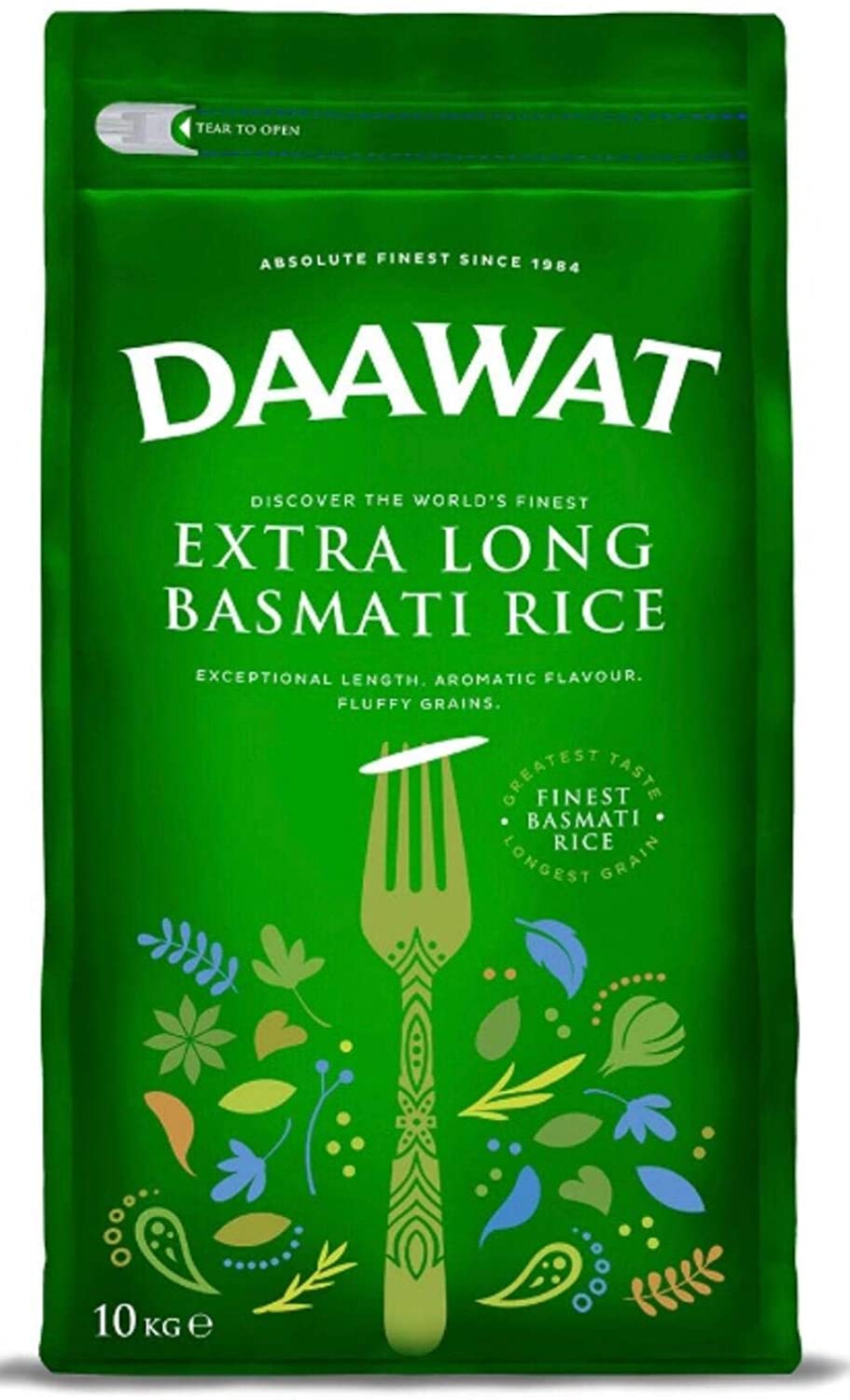
12. Basmati Rice Popular Brands
1. Daawat Extra Long Basmati Rice: Daawat Extra Long Basmati Rice is renowned for its exceptional length, aromatic fragrance, and distinct taste. Sourced from the fertile plains surrounding the Himalayan foothills, Daawat Basmati rice undergoes careful cultivation and processing to preserve its premium quality. With grains that elongate upon cooking, this rice variety is a preferred choice for creating exquisite dishes such as biryanis and pilafs. The brand's commitment to providing an authentic Basmati experience has earned it a place of distinction in the world of premium rice.
2. East End Premium Brown Basmati Rice: East End Premium Brown Basmati Rice stands out for offering a healthier twist to the traditional Basmati experience. Known for its premium quality, this brand provides brown Basmati rice, retaining the natural bran layer for added fiber and nutrients. This makes it a nutritious choice for those seeking a whole-grain option while still enjoying the aromatic and flavorful qualities of Basmati rice. With its commitment to quality and health-conscious consumers, East End's brown Basmati rice caters to a diverse range of dietary preferences.
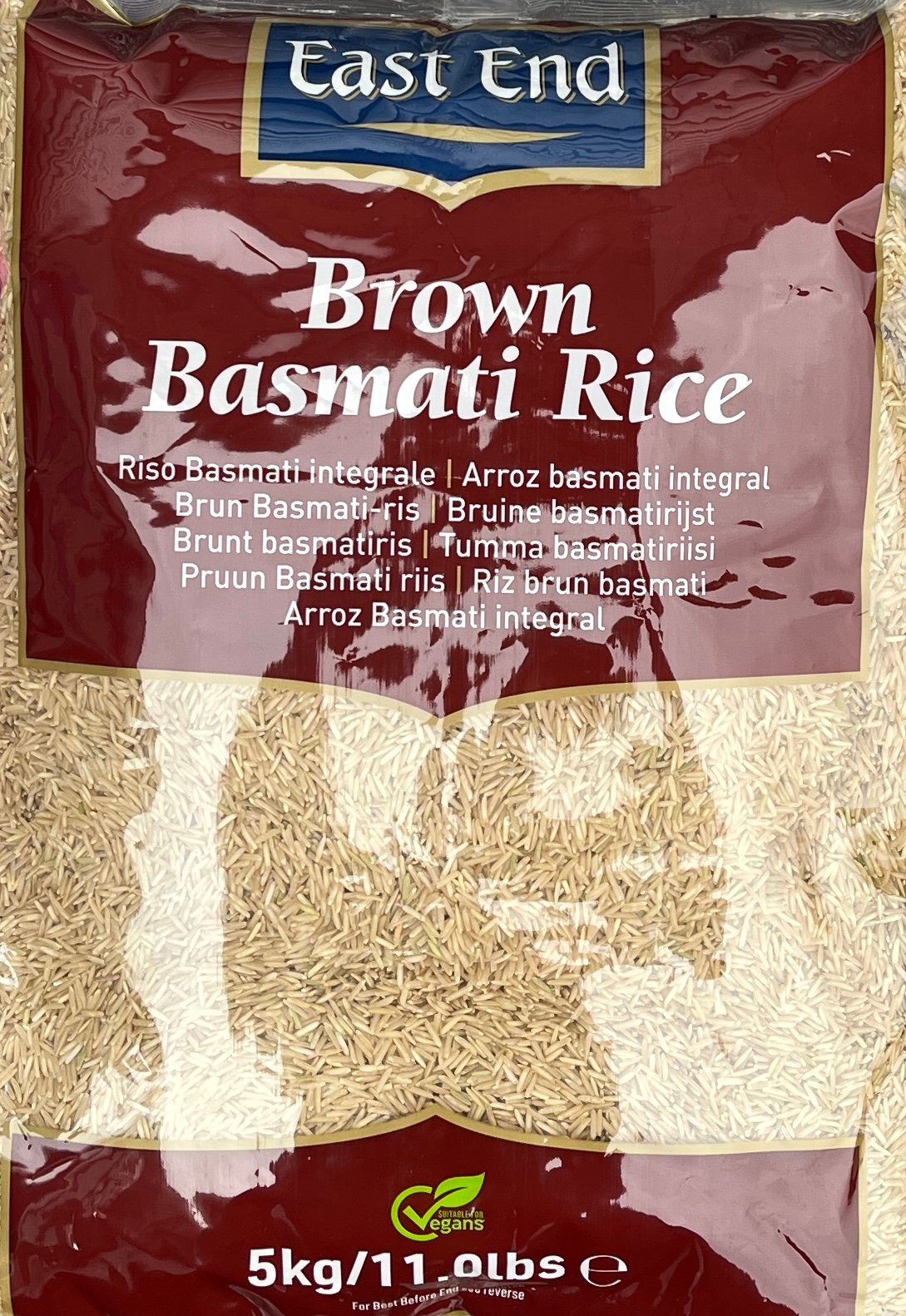
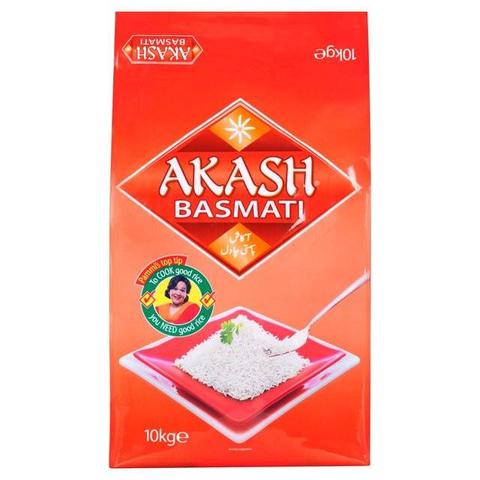
3. Akash Basmati Rice: Akash Basmati Rice is celebrated for its aromatic fragrance and long-grain quality. Sourced from regions with ideal growing conditions, Akash Basmati rice undergoes careful cultivation and processing to ensure consistent quality. Known for its versatility in the kitchen, Akash Basmati rice is suitable for various culinary applications, from traditional South Asian dishes to global fusion recipes. With a reputation for delivering a true Basmati experience, Akash has become a trusted choice for those who appreciate the distinctive qualities of this fragrant and flavorful rice.
4. Kohinoor Platinum Basmati Rice: Kohinoor Platinum Basmati Rice is known for its premium quality and distinct fragrance. Sourced from the Himalayan foothills, this Basmati rice undergoes careful cultivation and processing to ensure long grains and an aromatic profile. The Platinum variant is often associated with a higher grade, offering a refined dining experience. With a price point of £27.99 for a 10kg pack, Kohinoor Platinum caters to those seeking an elevated Basmati rice experience and is likely to be a choice for special occasions or discerning palates.
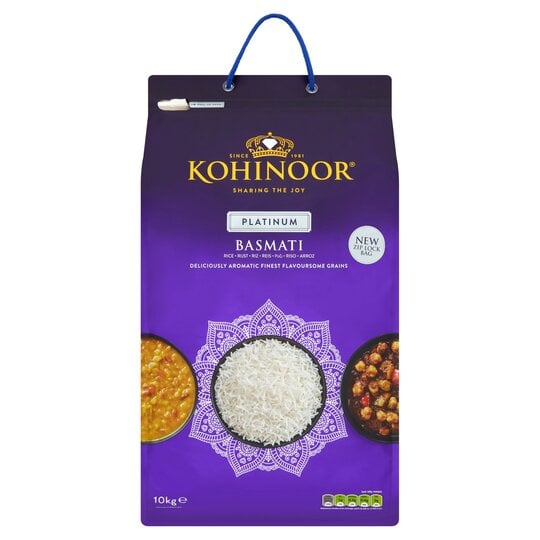
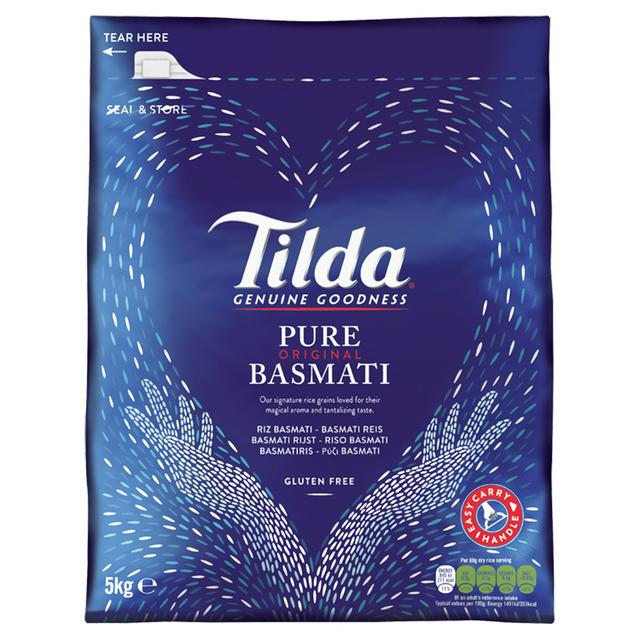
5. Tilda Basmati Rice: Tilda is a well-established brand in the Basmati rice market, known for its commitment to quality and consistency. The Tilda Basmati Rice range includes both 5kg and 10kg options, providing versatility for various household needs. Tilda Basmati Rice is celebrated for its fragrance, long grains, and ability to complement a wide array of dishes. Tilda offers a balance between quality and affordability, making it a popular choice among consumers looking for a reliable Basmati rice brand.
6. Veetee Mega Basmati Rice: Veetee Mega Basmati Rice, available in a 10kg pack, is known for its extra-long grains and aromatic fragrance. The Mega variant suggests a premium quality, and Veetee is recognized for its commitment to providing high-quality rice products. This Basmati rice is likely to appeal to those who appreciate the traditional characteristics of Basmati, including its fluffy texture and distinct aroma. With a larger pack size, it's suitable for households with higher consumption or those who prefer to buy in bulk.
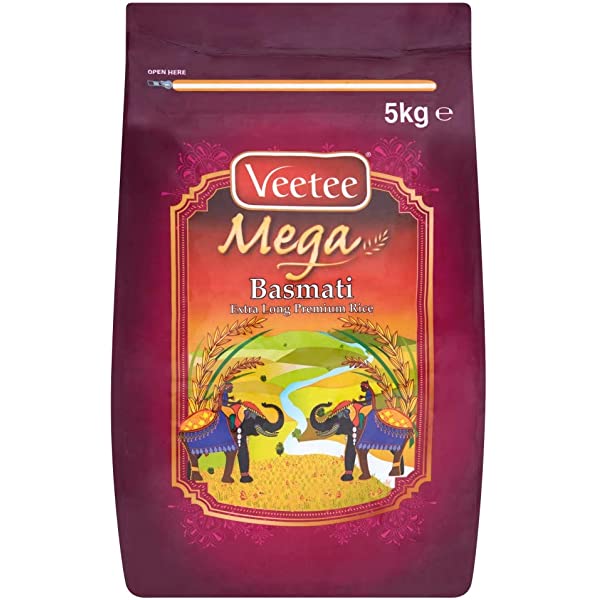
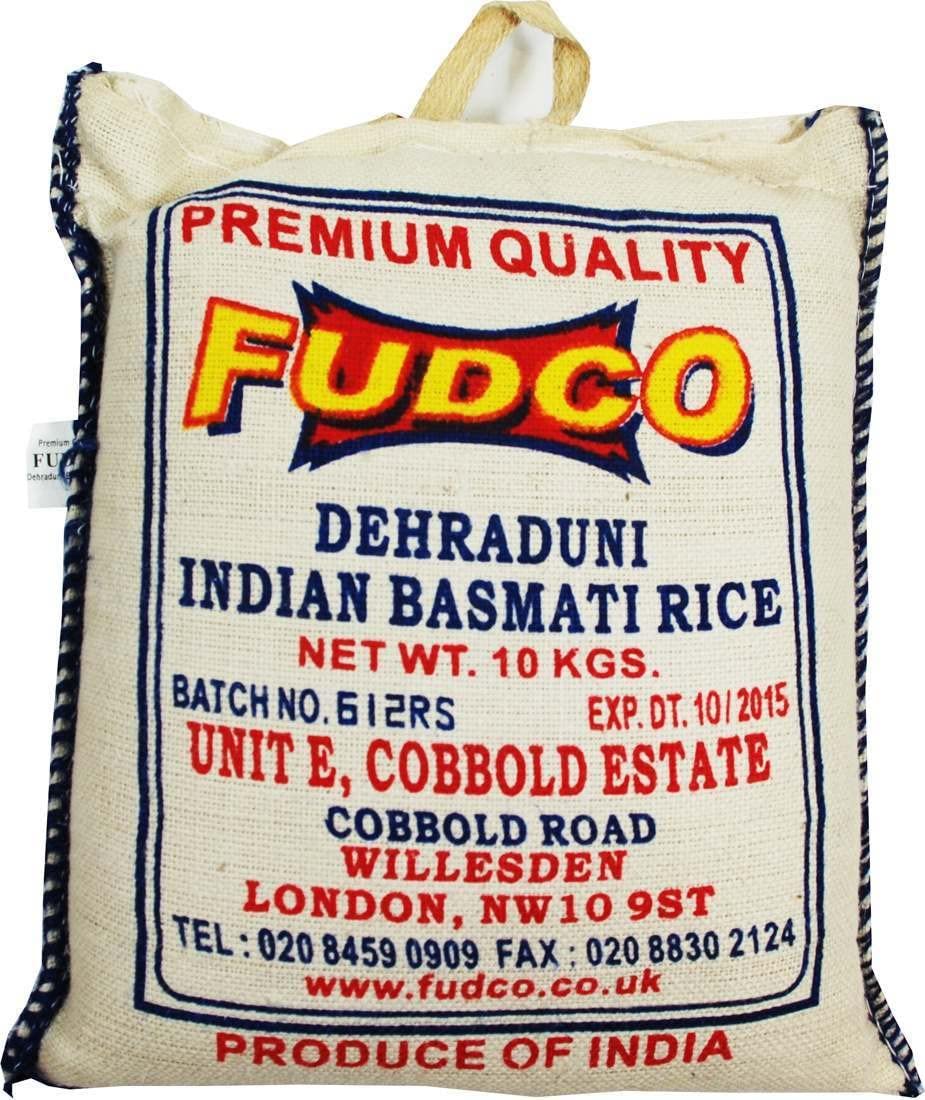
7. Fudco Dehraduni Basmati Rice: Fudco Dehraduni Basmati Rice, offered in a 5kg pack, brings the aromatic and flavorful experience of Basmati rice to the table. The brand is known for sourcing quality rice from the Dehradun region, which is renowned for producing fragrant Basmati varieties. Fudco's Basmati rice is likely to appeal to those who seek a balance between quality and affordability. The 5kg pack size makes it suitable for various household needs, providing flexibility for different culinary occasions.
13. Basmati Rice Future Trends and Market Projections: A Glimpse into Tomorrow's Grain
13.1 Emerging Trends in Basmati Rice Consumption:
1. Health and Wellness Focus: An emerging trend in Basmati rice consumption revolves around health and wellness. As consumers increasingly prioritize healthier lifestyles, there is a growing interest in whole-grain and nutrient-rich options, including brown Basmati rice. Brands may respond by diversifying their product lines to cater to health-conscious consumers seeking both flavor and nutritional benefits.
2. Sustainable and Ethical Sourcing: Environmental consciousness is influencing food choices, and Basmati rice consumers are showing interest in sustainably and ethically sourced products. Brands may adapt by emphasizing their commitment to environmentally friendly farming practices, fair trade initiatives, and transparent supply chains to align with consumer values.
3. Convenience and Ready-to-Eat Options: With busy lifestyles becoming the norm, there is a rising demand for convenience in food preparation. Future trends may see an increase in ready-to-eat Basmati rice products, such as microwavable rice pouches or pre-cooked rice options, catering to consumers looking for quick and hassle-free meal solutions.
13.2 Technological Advancements in the Industry:
1. Precision Farming and Smart Agriculture: Technological advancements in agriculture, including precision farming and smart agriculture practices, are likely to impact Basmati rice cultivation. Integration of sensors, data analytics, and automation may optimize crop management, resource utilization, and yield prediction, contributing to sustainable and efficient farming practices.
2. Biotechnology for Crop Improvement: Continued research in biotechnology may lead to the development of Basmati rice varieties with enhanced traits such as resistance to pests, diseases, and environmental stressors. Biotechnological approaches may contribute to improved yields, quality, and resilience in the face of changing climate conditions.
13.3 Market Predictions and Forecasts:
1. Global Demand and Expansion: Market predictions suggest a continued global demand for Basmati rice, driven by its unique aroma and versatile culinary applications. Growing popularity in non-traditional markets and the increasing influence of South Asian cuisine worldwide contribute to the expansion of the Basmati rice market.
2. Premiumization and Specialty Offerings: As consumer preferences evolve, there is a forecasted trend toward premiumization in the Basmati rice market. Brands may focus on offering specialty Basmati rice variants, emphasizing unique characteristics, and providing an elevated culinary experience for discerning consumers willing to invest in quality.
3. E-commerce and Direct-to-Consumer Sales: The rise of e-commerce platforms and direct-to-consumer sales channels is expected to play a significant role in the future Basmati rice market. Consumers seeking convenience and a broader product range may increasingly turn to online platforms for purchasing Basmati rice, influencing distribution trends.
In navigating the future of Basmati rice, the industry is poised for innovation, responding to shifting consumer preferences, technological advancements, and global market dynamics. As the demand for premium, sustainable, and convenient food options continues to rise, Basmati rice is likely to maintain its status as a cherished and sought-after culinary staple.

